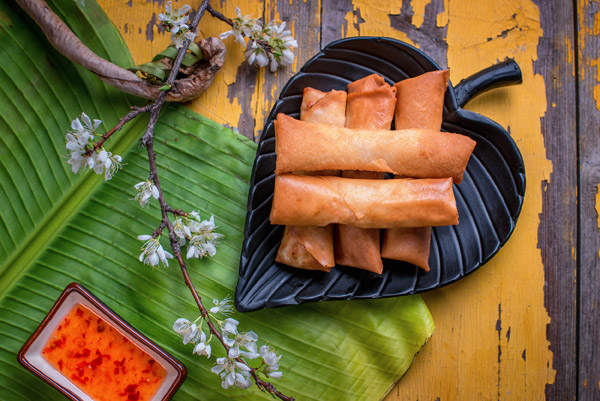 |
|
The eating of spring rolls is more ritualistic and seasonal in the cold north.[Photo provided to China Daily] |
She wrapped vegetables and meat inside a flour crepe so he can bite into it easily. I guess this is the Chinese version of the Earl of Sandwich story.
The eating of spring rolls is more ritualistic and seasonal in the cold north.
My sisters-in-law come home with a pile of spring roll wrappers every spring. Then they prepare blanched bean sprouts, finely shredded omelette, blanched garlic chives and perhaps a light sprinkle of toasted krill for seasoning.
A little saucer of Beijing sweet bean sauce will also be there to dip the rolls in.
These are the fresh rolls. Smaller crepes are often deep-fried to a crisp in hot oil. These may be leftovers from the first spring meal, or they could be delicately crafted snacks that "touch the heart", the world famous dim sum or dianxin.
The fried spring roll is a must-have item on the dim-sum cart, and when the Cantonese chefs went abroad and started yum-cha restaurants in Chinatowns all over the world, they brought along the spring roll.
It eventually evolved into a firm favorite with Asian and Western diners and in many countries, it is now a major contributor to local cuisine.
Think of the Vietnamese spring rolls in all their glorious presentations, from soft rice-paper rolls stuffed with seafood and herbs, deep fried rolls full of minced meat, mushrooms and glass noodles ...
In the Philippines, the Chinese introduced the lumpia, which became fuller, meatier and crisp with flavor.
In Southeast Asia, spring rolls became popiah, or baobing. And in the equatorial heat, they became favorites all year round, and the rolls are spiced up with fried garlic, ground peanuts, sliced Chinese sausages, prawns and ... chili sauce.
In America, the spring roll stayed true to its form in dim-sum restaurants, but, together with other dishes adapted for the American palate, it became huge egg rolls in Chinese restaurants, suitably up-sized for local appetites.
At home and abroad, this little snack has tenaciously survived the tests of time and distance. No one really remembers its humble and bland origins, but it is certainly no longer confined to just being eaten in spring.
Spring roll wrappers are now easily available in any Chinese supermarket or Asian grocery, but I will never forget how I watched a wizened old woman create a pile of crepes by the roadside in Fujian.
She had a hot griddle on coals in front of her, and she was twirling a very soft ball of dough in her right hand. She had to keep spinning it to keep it together. Every two minutes of so, she wiped the dough ball on the griddle, leaving behind a thin layer of batter which instantly formed a white crepe.
Using a wooden spatula, she flipped the crepe over to join the growing pile by the griddle, and was already wiping the dough a second time on the hot plate before the first had fully settled on the pile.
It was mesmerizing, this one-woman production line.
I squatted by her side and fired questions at her in my halting Fujianese and she smilingly answered every one, without missing a beat in her crepe-making.
It's just salt, flour and water, but that was the best bit of cooking alchemy that I had ever seen. Her crepes were chewy, salty and firm enough to contain the dripping vegetable stew without breaking. Perfect.
Spring rolls can make a fascinating meal for a jovial gathering of friends, or family. Try them soon.
paulined@chinadaily.com.cn